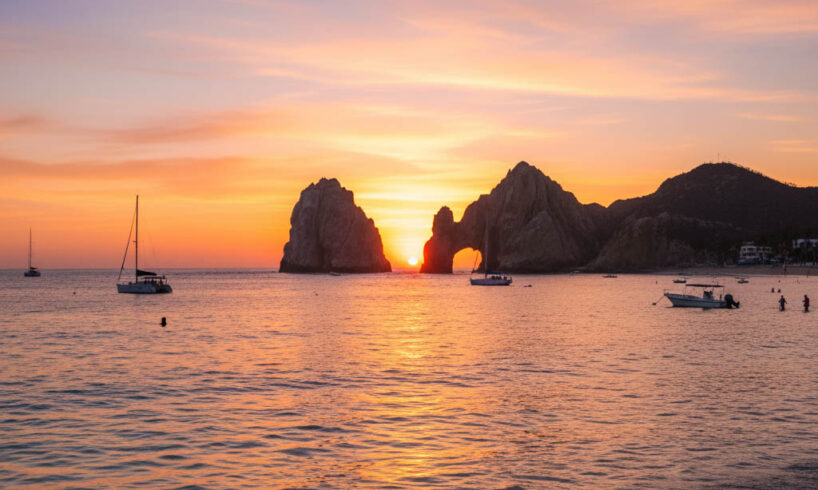
Home » Latest Travel News » Los Cabos Joins Cancún, Puerto Vallarta, Mexico City in Boosting Tourism Economy and Attracting Tourists from Canada, US, Brazil and Argentina, New Update is Here
Published on
October 11, 2025
By: Tuhin Sarkar
Los Cabos, joining the ranks of popular Mexican destinations like Cancún, Puerto Vallarta, and Mexico City, is significantly boosting the tourism economy by attracting visitors from major source markets including Canada, the US, Brazil, and Argentina.
With its stunning beaches, luxurious resorts, and world-class amenities, Los Cabos has become a key player in Mexico’s tourism sector. This surge in tourism is not just benefiting Los Cabos but also reinforcing Mexico’s position as a global travel hub. As more tourists from Canada, the US, Brazil, and Argentina flock to this vibrant destination, the local economy continues to thrive.
The influx of international visitors, particularly from the US and Canada, has become a driving force for Los Cabos, much like the other leading cities of Cancún, Puerto Vallarta, and Mexico City. The combined efforts to enhance accessibility and improve the visitor experience are pushing Los Cabos further into the spotlight, contributing to Mexico’s overall tourism growth.
Los Cabos: The Emerging Winter Tourism Destination in Mexico for 2025 and Its Competitive Edge
Los Cabos, located at the southern tip of Mexico’s Baja California Peninsula, has long been a popular destination for travelers seeking sun, luxury, and adventure. As winter approaches, 2025 is shaping up to be a pivotal year for the region, with tourism numbers expected to hit unprecedented levels. But how does Los Cabos measure up against other well-established destinations in Mexico? This report takes an in-depth look at Los Cabos’ tourism outlook for winter 2025, compares it with other major Mexican cities, and examines the strategies that are making Los Cabos a leading destination for tourists worldwide.
Los Cabos: A Tourism Powerhouse in 2025
Los Cabos has consistently shown strong growth in recent years, and the winter season of 2025 promises to be no different. According to recent data, the region is expected to surpass 4 million visitors in 2025, which would mark a record-breaking year for the destination. This is part of a larger trend in which Los Cabos has experienced a 16% growth in tourism, far outpacing the national average growth rate of 10.7%.
The region has become one of the most sought-after travel destinations, thanks in part to its breathtaking landscapes, pristine beaches, world-class resorts, and exceptional customer service. Air connectivity plays a crucial role in this growth. Between October and March, Los Cabos is expected to see a 12% increase in available airline seats from the United States, one of its largest markets. This is a significant boost for the destination, as it indicates rising demand and greater accessibility for international travelers. In 2024, Los Cabos International Airport, Mexico’s sixth-busiest airport, handled over 7.5 million passengers, with approximately 4.7 million of those being international arrivals.
This increase in air traffic is a direct response to the growing popularity of Los Cabos. As international tourists flock to the region for its winter warmth, the influx of visitors is expected to further fuel the region’s economic growth. The 38% return visitor rate, nearly matching the peak observed in 2021, also suggests that Los Cabos is successfully retaining visitors and turning them into loyal tourists.
Mexico’s Tourism Landscape: A Resilient Recovery
While Los Cabos continues to be a star performer, the broader Mexican tourism sector is also on the rise. In 2024, Mexico welcomed approximately 45 million international visitors, reflecting a 7.4% increase compared to the previous year. The growth trajectory continued into 2025, with 47.4 million international visitors recorded between January and July, a robust 13.8% year-over-year increase.
Tourism expenditure has also risen significantly, with international visitors spending $32.96 billion in 2024, surpassing pre-pandemic levels by 34%. This financial growth highlights Mexico’s resilience in the face of global challenges, and the tourism sector’s contribution to the country’s economic recovery cannot be overstated.
While the United States and Canada remain Mexico’s largest source markets, the country has also seen growth from emerging markets, further diversifying its tourism revenue streams. As winter approaches in 2025, Mexico is on track for another strong year, thanks to its robust tourism infrastructure, diverse destinations, and a variety of experiences for travelers.
Comparing Los Cabos to Other Major Mexican Destinations
Los Cabos is not alone in its success; other Mexican cities like Cancún, Puerto Vallarta, and Mexico City also remain highly competitive on the global tourism stage. However, when comparing the growth trends and tourism measures, Los Cabos is emerging as one of the standout destinations for winter tourism in 2025.
Cancún: The Dominant Leader in Mexican Tourism
Cancún, Mexico’s most visited tourist destination, remains the undisputed leader in terms of international arrivals. In 2024, Cancún welcomed nearly 9.72 million international visitors, continuing to hold the title of the busiest airport in Mexico. The region’s proximity to the United States and its all-inclusive resorts make it a perennial favorite for tourists looking for both relaxation and adventure.
Despite its dominance, Cancún’s growth rate has been relatively stable in recent years, with some signs of plateauing. The occupancy rate in 2023 was 75.6%, which, while still impressive, is lower than the levels experienced in previous years. This indicates that while Cancún continues to perform strongly, other destinations like Los Cabos are beginning to capture a larger share of the tourism market.
Puerto Vallarta: A Strong Competitor in Cruise Tourism
Puerto Vallarta, located on Mexico’s Pacific coast, is another key player in the Mexican tourism industry. Known for its vibrant culture, stunning beaches, and as a major cruise port, Puerto Vallarta has seen solid growth in recent years. In 2024, Puerto Vallarta welcomed approximately 1.85 million international visitors, making it one of the top destinations for cruise tourists.
In 2025, the city is focusing on expanding its cruise tourism market by reducing fees for cruise ships, with fees being slashed by up to 90%. This is a strategic move aimed at attracting more cruise lines to the port, which will further boost the region’s tourism figures.
However, Puerto Vallarta still faces competition from other destinations such as Los Cabos, which has been increasingly attracting affluent travelers looking for a more luxurious and exclusive experience. With its high-end resorts, celebrity clientele, and increasing air connectivity, Los Cabos is emerging as the more fashionable choice for many travelers.
Mexico City: A Bustling Metropolis with Complex Challenges
Mexico City, the capital of Mexico, is another major tourism hub, attracting millions of visitors each year. In 2024, the city saw 4.24 million international arrivals. The city offers a blend of culture, history, and modernity, making it a popular destination for both business and leisure travelers.
However, Mexico City is facing significant challenges related to overtourism. Protests against rising housing costs, gentrification, and the impact of mass tourism on local communities have created a complex environment for the tourism industry. In comparison to Los Cabos, which has implemented measures to balance growth and sustainability, Mexico City’s tourism industry is grappling with some of the negative externalities of rapid growth.
Winter Tourism Measures and Infrastructure Enhancements in Los Cabos
To prepare for the surge in visitors during the winter season, Los Cabos is investing heavily in infrastructure and adopting a series of measures designed to enhance the overall visitor experience.
Increased Air Connectivity
One of the most significant developments is the 12% increase in available airline seats between October and March. This increase will help accommodate the growing number of U.S. tourists who flock to Los Cabos for its winter warmth. With direct flights from major U.S. cities, Los Cabos is well-positioned to capture a significant portion of the winter tourism market.
Expanding Hotel Capacity
Los Cabos is also focused on expanding its hotel capacity to meet the growing demand. Over the past seven years, the region has added 6,000 new hotel rooms, with more developments underway. This expansion ensures that the destination can accommodate both luxury travelers and those seeking more affordable options.
Enhanced Visitor Experience
Tourists visiting Los Cabos consistently rate their experiences highly. In February 2025, 70% of visitors said their expectations were exceeded. This is a result of Los Cabos’ commitment to customer satisfaction, including improvements in safety, service, and the quality of amenities.
Mexico’s Tourism Boom: A Deep Dive into Source Markets and 2025 Growth Projections
Mexico’s tourism sector has been flourishing, and 2025 promises to be a landmark year for the industry. With a range of new initiatives, growing international visitor numbers, and strategic infrastructure improvements, Mexico is poised to maintain its position as one of the most popular travel destinations in the world. This report provides an in-depth look at the key source markets driving Mexico’s tourism growth, including the United States, Canada, Latin America, Europe, and Asia. It also explores the strategic moves being made to accommodate this rising demand and ensure the country remains a top choice for global travelers.
Key Source Markets Driving Mexico’s Tourism Growth
Mexico’s tourism industry is experiencing a significant boom, with international arrivals hitting new heights in 2024 and continuing to rise in 2025. According to recent data, approximately 45 million international visitors arrived in Mexico in 2024, marking a 7.4% increase from the previous year. This upward trajectory continued into 2025, with 14 million international air travelers arriving in the first eight months alone, reflecting a 1% increase compared to the same period in 2024.
The increase in visitor numbers is largely driven by key source markets, including the United States, Canada, Latin America, Europe, and Asia. Let’s explore these markets in greater detail:
The United States: The Largest Source Market for Mexico
The United States remains Mexico’s largest source of international tourists. In 2025, the United States contributed approximately 9.55 million visitors to Mexico, representing a 1.3% increase from 2024. This growth reflects a 26.2% rise compared to 2019, highlighting the enduring appeal of Mexico to American travelers.
The strong cultural ties between the two countries, as well as proximity, play a key role in this trend. Many Americans are drawn to Mexico’s stunning beaches, vibrant cities, rich history, and affordable travel options. In addition, the rise of low-cost airlines and increased flight connectivity between major U.S. cities and Mexican destinations have made it easier than ever for U.S. citizens to travel to Mexico for leisure, business, and family visits.
Canada: A Growing Contributor to Mexico’s Tourism
Canada is another significant source market for Mexico’s tourism industry. In early 2025, over six million Canadian tourists visited Mexico, representing a 4.2% increase over the same period in 2024. The close relationship between Mexico and Canada, along with the increasing number of direct flights between the two countries, has contributed to this rise in Canadian visitors.
Canadians are drawn to Mexico’s diverse offerings, from its beach resorts to its historical landmarks and cultural festivals. The growth in Canadian tourism is expected to continue in 2025, driven by strong bilateral relations and Mexico’s increasing appeal as a year-round destination.
Latin America: Strong Ties with Neighboring Countries
Latin America, particularly countries such as Colombia, Argentina, and Brazil, continues to be an important source of visitors to Mexico. In 2024, Colombia contributed over 600,000 visitors to Mexico, while Argentina and Brazil each accounted for around 400,000. These markets are growing steadily, and the number of Latin American tourists visiting Mexico is expected to rise in 2025.
Shared cultural ties and geographical proximity make Mexico an attractive destination for Latin American travelers. Mexico’s history, cuisine, and tropical landscapes resonate strongly with tourists from this region, making it a natural choice for short-haul travel.
Europe: A Steady Stream of Visitors from the UK, France, and Germany
European travelers, particularly from the United Kingdom, France, and Germany, have been consistent visitors to Mexico. In 2024, over 580,000 British tourists visited Mexico, while France and Germany contributed approximately 305,000 and 286,000 visitors, respectively. European tourists are drawn to Mexico’s rich cultural offerings, including its historical sites, colonial architecture, and world-class cuisine.
Mexico has long been a popular destination for European tourists looking for a mix of history, adventure, and relaxation. As global travel demand continues to rise, it is expected that European markets will remain a key source of visitors in 2025 and beyond.
Asia: Growing Interest from Japan and China
Although Asian markets represent a smaller portion of Mexico’s total international tourism, the numbers are steadily increasing. In 2024, Japan contributed over 150,000 visitors to Mexico, while China added approximately 167,000. These markets are gradually becoming more important as Mexico continues to expand its global reach and attract tourists from across Asia.
The increase in air connectivity between Mexico and key Asian cities, such as Tokyo and Beijing, has made it easier for tourists from these regions to visit Mexico. With Mexico’s rising international profile, it is expected that Asian markets will continue to show interest in the country in the coming years.
Mexico’s Tourism Infrastructure: Strategic Investments and Improvements
To accommodate the growing influx of international visitors, Mexico is making significant investments in its tourism infrastructure. This includes improvements to airports, transportation networks, and tourist facilities across the country.
Airport Enhancements
One of the most important areas of infrastructure improvement is Mexico’s airports. Grupo Aeroportuario del Pacífico (GAP), a key airport operator in the country, has announced a $2.5 billion investment plan through 2029 to expand airport capacities and enhance connectivity. This investment will help meet the growing demand for international flights and improve the overall travel experience for tourists arriving in Mexico.
Sustainable Tourism Initiatives
Mexico is also increasingly focusing on sustainable tourism practices to preserve its natural and cultural heritage. Several destinations are implementing eco-friendly accommodations, promoting sustainable travel options, and supporting local communities. In addition, Mexico has launched several conservation programs aimed at preserving its unique biodiversity, including efforts to protect its beaches, forests, and marine life.
These sustainability efforts align with global trends in responsible tourism, and Mexico is positioning itself as a destination that not only offers incredible experiences but also takes steps to protect its environment for future generations.
The Role of Cruise Tourism in Mexico’s Growth
Mexico is also a major player in the global cruise industry. In 2024, over 5.7 million cruise passengers visited Mexico, a 9.6% increase from the previous year. Key cruise ports such as Cozumel, Puerto Vallarta, and Mazatlán continue to attract millions of tourists seeking diverse itineraries and enriching experiences. Mexico’s warm waters, rich cultural offerings, and vibrant port cities make it an ideal destination for cruise tourists from around the world.
With cruise tourism continuing to grow, Mexico is making efforts to improve its cruise infrastructure, including investing in port facilities and creating new tourist experiences for cruise passengers. This sector is expected to continue to play a key role in Mexico’s tourism economy in 2025 and beyond.
Mexico’s Vision for the Future: Investments and Growth in the Tourism Sector
Mexico’s tourism industry is on track for continued growth, with plans in place to further enhance the country’s infrastructure, promote sustainable tourism practices, and attract a diverse range of international visitors. The government and private sector are working together to ensure that Mexico remains a top destination for tourists from around the world.
In addition to expanding airport capacity, improving transportation networks, and enhancing tourism facilities, Mexico is focusing on boosting its tourism offerings by creating new attractions, hosting international events, and marketing lesser-known destinations. These efforts aim to spread the benefits of tourism across the country and reduce the pressure on popular hotspots like Cancún and Mexico City.
Mexico is also prioritizing the growth of its cultural and adventure tourism sectors. With its rich history, diverse ecosystems, and world-class cuisine, Mexico offers a wide variety of experiences for all types of travelers, from culture seekers to nature lovers and adventure enthusiasts.
A Bright Future for Mexico’s Tourism Industry
Mexico’s tourism industry is thriving, with strong demand from key source markets such as the United States, Canada, and Latin America, as well as growing interest from Europe and Asia. The country’s investments in infrastructure, sustainable tourism practices, and cruise tourism will help ensure that Mexico remains a top destination for international travelers in 2025 and beyond.
As the tourism industry continues to grow, Mexico is well-positioned to capitalize on its strengths and offer visitors unforgettable experiences. From its stunning beaches and cultural heritage to its modern cities and rich cuisine, Mexico has something for every traveler. With strategic investments, enhanced connectivity, and a commitment to sustainability, Mexico’s tourism sector is poised for continued success in the coming years.
Los Cabos: The Ultimate Travel Guide to Mexico’s Premier Coastal Destination
Los Cabos, located at the southern tip of Mexico’s Baja California Peninsula, is a vibrant fusion of natural beauty, luxury, and adventure. Known for its stunning beaches, world-class resorts, and vibrant nightlife, Los Cabos has earned its reputation as one of Mexico’s top destinations. Whether you’re a first-time visitor or a returning traveller, this guide will help you make the most of your time in Los Cabos, with everything you need to know about the area’s best attractions, accommodations, and travel tips.
Unveiling the Best Attractions in Los Cabos
Los Cabos offers something for everyone, from beautiful beaches and outdoor adventures to cultural experiences and exciting nightlife. Here are some must-visit attractions that should be on your radar during your visit.
El Arco de Cabo San Lucas
No visit to Los Cabos is complete without seeing El Arco, the iconic natural rock formation where the Pacific Ocean meets the Sea of Cortez. Accessible by boat, El Arco is a stunning sight, with its towering rocks creating a dramatic landscape. It’s a fantastic spot for photographs, and you might even spot sea lions sunbathing on the rocks. Many boat tours also offer snorkeling opportunities nearby, making it an unforgettable experience.
Chileno Bay
Chileno Bay is a protected marine sanctuary that has gained popularity for its crystal-clear waters, perfect for snorkeling and swimming. The bay is home to vibrant coral reefs and diverse marine life, making it an ideal destination for nature lovers. Whether you’re a seasoned snorkeler or just getting started, Chileno Bay offers an accessible and stunning environment to explore Mexico’s underwater world.
Cabo Pulmo National Park
A bit further from the hustle and bustle of Cabo San Lucas, Cabo Pulmo National Park is one of the most important marine reserves in the region. This UNESCO World Heritage site is known for its rich biodiversity, including schools of fish, sea turtles, and even hammerhead sharks. Snorkeling and diving are the best ways to explore the coral reefs here, which are considered some of the most vibrant in the world.
Medano Beach
Medano Beach is the heartbeat of Cabo San Lucas. Stretching for over a mile, this beach is bustling with activity. It’s perfect for water sports such as jet skiing, parasailing, and paddleboarding. If you prefer a more relaxing day at the beach, plenty of beachfront bars and restaurants are nearby, offering food, drinks, and the opportunity to watch the world go by. The beach is also within walking distance of the marina, making it a central spot for both relaxation and exploration.
Land’s End
The dramatic cliffs of Land’s End are where the Pacific Ocean meets the Sea of Cortez. Aside from the famous El Arco, the area is home to stunning rock formations, clear blue waters, and sea lion colonies. Whether you choose to take a boat tour, rent a kayak, or simply enjoy the view from a beachside restaurant, Land’s End is a must-see for any visitor to Los Cabos.
Where to Stay: From Luxury Resorts to Cozy Rentals
Los Cabos is home to a wide variety of accommodations, ranging from luxurious all-inclusive resorts to charming boutique hotels and vacation rentals. Here are some of the top options for your stay in this beautiful coastal destination.
Luxury Resorts and Hotels
Los Cabos is renowned for its luxury resorts, many of which are located along the pristine beaches and offer all-inclusive services. These high-end resorts provide everything you need for a memorable vacation, from gourmet dining and spa treatments to private beaches and poolside service.
Hotel Riu Santa Fe: Located on the shores of Medano Beach, Hotel Riu Santa Fe is a sprawling all-inclusive resort that offers multiple pools, a water park, and diverse dining options. It’s a great choice for families and groups seeking convenience and luxury.Hotel Riu Palace Baja California: If you’re looking for an adults-only retreat, this all-inclusive resort offers a sophisticated atmosphere, with luxurious rooms, a beachfront location, and top-notch amenities.Grand Solmar Land’s End Resort & Spa: For those who want to indulge in luxury, Grand Solmar offers stunning oceanfront views, an award-winning spa, and gourmet dining. It’s the ideal place for a romantic getaway or a serene escape.The Westin Los Cabos Resort Villas & Spa: This wellness-focused resort offers spacious villas, a state-of-the-art fitness centre, and a tranquil spa. It’s perfect for visitors who want to combine relaxation with wellness.Airbnb Rentals
For those looking for a more personalized or affordable stay, Los Cabos offers a wide range of vacation rentals, from modern condos to private villas. Airbnb has become a popular choice for visitors seeking unique, private accommodations with more flexibility. Whether you want a beachfront condo or a luxurious villa with a private pool, you’ll find a range of options suited to your preferences.
Private Villas: If you prefer privacy and exclusivity, private villas in Los Cabos offer spacious living, full kitchens, and often, stunning ocean views. Many of these homes come with private pools and staff, allowing you to unwind in the utmost comfort.Condos Near Medano Beach: Modern condos in the heart of Cabo San Lucas are perfect for those who want to be close to the action. These properties are within walking distance of restaurants, shops, and nightlife while offering amenities like full kitchens, Wi-Fi, and stunning views.Boutique Homes: Unique boutique homes in Los Cabos combine traditional Mexican architecture with contemporary design. These charming properties allow you to experience the local culture while enjoying modern comforts.
Airlines and Connectivity: How to Get There
Los Cabos International Airport (SJD) is one of Mexico’s busiest airports, offering excellent connectivity to destinations across the globe. The airport serves as a major gateway for travelers heading to the Baja California Peninsula, and it is well-served by a variety of international and domestic airlines.
Airlines Operating to Los CabosAmerican AirlinesDelta Air LinesUnited AirlinesAlaska AirlinesAir CanadaSouthwest Airlines
These airlines provide direct flights to Los Cabos from major cities in the United States, Canada, and select international destinations. The increasing number of flights makes it easy to reach Los Cabos from cities across North America, making it a convenient destination for international travelers.
Airport Expansion
To keep up with the growing demand, Los Cabos International Airport is undergoing significant expansion. Grupo Aeroportuario del Pacífico (GAP), the airport operator, has announced a $2.5 billion investment plan through 2029. This investment will increase airport capacity and improve the overall travel experience for visitors, ensuring that Los Cabos can handle the growing number of international tourists expected in the coming years.
When to Visit Los Cabos: Best Time to Travel
The best time to visit Los Cabos largely depends on your preferences. The region enjoys a mild desert climate, with sunny weather year-round, but there are some things to consider when planning your trip.
Peak Season (December to April)
The peak season in Los Cabos coincides with the winter months, from December to April. During this time, the weather is perfect—sunny, warm, and dry—with daytime temperatures hovering around 80°F (27°C). This is the best time to visit if you want to avoid the summer heat, especially for outdoor activities like snorkeling, whale watching, and hiking.
Off-Season (May to November)
While Los Cabos is a year-round destination, the off-season from May to November offers more budget-friendly options. The weather can be hotter during this time, with temperatures reaching over 90°F (32°C), but it’s also when the region sees fewer tourists, making it ideal for those seeking a quieter, more relaxed experience.
Whale Watching Season
If you visit Los Cabos during the winter months (December to April), you’ll be treated to one of the most exciting wildlife experiences in the region: whale watching. Every year, thousands of grey whales migrate from the Arctic to the warm waters off the coast of Baja California. Boat tours provide excellent opportunities to see these magnificent creatures up close.
Savor the Flavors of Los Cabos: Dining and Nightlife
Los Cabos boasts a culinary scene that caters to all tastes, from street tacos to fine dining. Local seafood is the star of the show, with restaurants serving everything from fresh ceviche to grilled fish. Enjoy a meal at Flora’s Field Kitchen, an organic farm-to-table restaurant that offers locally sourced dishes in a beautiful outdoor setting.
When the sun sets, Los Cabos comes alive with vibrant nightlife. Whether you’re looking for laid-back bars, upscale lounges, or full-throttle nightclubs, you’ll find something to suit your style. Cabo Wabo, owned by rock legend Sammy Hagar, is a famous spot for live music and dancing. For a more relaxed evening, head to one of the beachfront bars to watch the sunset with a cocktail in hand.
Conclusion: Los Cabos Awaits Your Arrival
Los Cabos is more than just a beach destination; it’s a place where luxury, adventure, and nature come together to offer an unforgettable travel experience. With stunning attractions, world-class accommodations, and excellent connectivity, Los Cabos is a destination that should be at the top of your travel list. Whether you’re planning a romantic getaway, a family vacation, or a solo adventure, Los Cabos promises to deliver everything you need for a perfect escape.
The Future of Los Cabos Tourism: Key Takeaways
Los Cabos is quickly becoming the premier destination for winter tourism in Mexico. With strong growth trends, increasing air connectivity, expanding hotel capacity, and a focus on delivering high-quality experiences for visitors, Los Cabos is well-positioned for sustained success in 2025 and beyond. The region’s ability to balance growth with sustainability will be key in maintaining its competitive edge as Mexico’s tourism sector continues to recover and evolve.
While other destinations like Cancún, Puerto Vallarta, and Mexico City remain important players in Mexico’s tourism industry, Los Cabos’ unique blend of luxury, natural beauty, and exceptional service makes it a standout choice for travelers seeking an unforgettable winter escape. As Los Cabos continues to evolve, it will undoubtedly attract even more visitors from around the world, cementing its place as a leading global destination.





